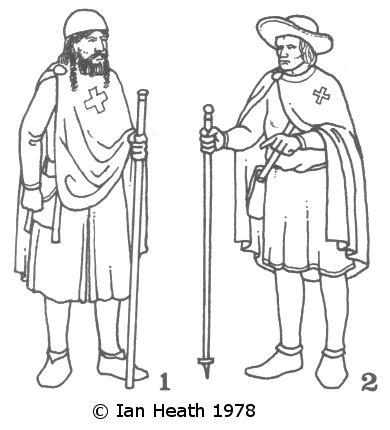|
Download 2 free e-books from Amazon Audible |

Try Amazon Fresh
PILGRIMS
An extract from Armies and Enemies of the Crusades 1096-1291by Ian Heath
[Based on a Crusader. Relief from the Abbey of Belval]

|
Download 2 free e-books from Amazon Audible |


1 & 2. PILGRIMS
The distinguishing feature of all crusaders was the cross, worn ‘on the shoulders of their mantles or cassocks or tunics’ once they had declared their intention to go on a crusade.
Although the shoulder or right breast seem to have been the most common places to wear the cross it is also recorded worn between the shoulders (apparently signifying the pilgrim to be returning from crusade). It normally consisted of a cruciform piece of cloth sewn onto everyday clothes. Traditionally it was red in colour but, although this was generally the case, by the Third Crusade of 1189-1192 certain colours had begun to adopt national meaning - red for the French, green for the Flemish, white for the English and yellow for the Germans. To a certain extent these distinctions lasted into the 13th century when, for example, Simon de Montfort’s army at Lewes in 1264 wore ‘the white cross of the crusader’, while the French who fought against Manfred of Sicily in 1266 wore red crosses (the enterprise having been declared a crusade). By the very end of this period, however, the red cross had become a national insignia of not the French but the English, while conversely the white cross (often on a blue background) was nationally adopted by the French rather than the English! Undoubtedly crosses of any colour could be found in any army at any time, depending on what material was to hand at the moment of ‘taking the cross’; many nobility, for instance, wore crosses of such substance as woven gold.
These figures are typical of the ‘non-combatants’ who accompanied the early crusades in vast numbers. Both date to c. 1170 and wear everyday clothes. They carry the characteristic staff and wallet or scrip-hag, the latter suspended from a shoulder-strap.
Although some carried a bow or spear most were unarmed or only poorly equipped with farm implements and it is a heart-felt plea from more than one contemporary chronicler that more such pilgrims of the early crusade armies might have been equipped ‘with the sword instead of the wallet and the bow instead of the staff.’